



































MIDWEEK UPDATE 21 JULY 2022
Gbanner








CAF EXPOUNDS ON HIS "FREE THE EAGLE" VISION
defenceWeb

The three-star expounded on where he sees the airborne service of the national defence force going under his command during an interview with journalists from Ad Astra - the official SAAF publication.
His thinking, reported on SA National Defence Force (SANDF) social media, covers combat readiness, financial constraints, the importance of training and the importance of trust between leadership and the ranks.
Captain Tebogo August writes combat readiness across all capabilities - presumably referring to fighter aircraft, helicopters, air lift and general air transport - is a priority for Mbambo. This will be "achieved by benchmarking with air forces in the SA Development Community (SADC) and elsewhere in the international community".
Mbambo reportedly wants SAAF personnel to "develop a mind-set that protects state resources".
"In as much as members take care of home budgets and care for their households, they must extend the same positive attitude to state resources at the workplace because such resources must be spared for the coming generations. In high trust environments, people show up and do their best work, they gain productive energy, creativity, speed and better results. They align around a common purpose, take calculated risks, support each other and communicate openly and honestly," Mbambo is reported as saying in an interview.

On the issue of trust Mbambo has it that people are a barometer indicating whether leadership is moving in the right way to obtain the organisation's goals.
"There must be trust between leadership and members because people are the most important asset in any organisation. People cannot do their best work if they doubt others' intentions or capabilities, the direction or viability of the organisation or, most importantly, if they doubt their own ability to keep up with demands placed on them. This is especially true in today's environment of complex change and ambiguity when members are asked to do more with less."
Speaking about the arrival of democracy in South Africa, Mbambo said, "the liberation movement brought about change where everyone is today accepted in the SAAF". He emphasised "in its recruitment approach the air force has trained more women in South Africa who are today pilots in their own right." Mbambo further said the SAAF belongs to all the people of South Africa, including sons and daughters of peasants from the remotest rural areas of the country.

In May 2022, Schweizer delivered another new Schweizer 300C helicopter to the Senegalese Air Force. The Senegalese Air Force took delivery of the first production Schweizer 300C helicopter in July 2021.
In March 2022, the Foreign Asset Trade Company signed a follow-on contract with Schweizer for five additional Schweizer 300C helicopters for the air force. The first aircraft from this contract was delivered in May with the remaining deliveries scheduled before the end of the third quarter of 2022.
The five additional Schweizer 300C helicopters will support the Senegalese Air Force's flight training academy and will be used for ab- initio, instrument, and vertical reference training. Each is fully equipped for IFR flight training with Garmin GPS, Bendix King NavComs, Garmin Transponders with ADS-B out, and RC Allen digital artificial horizon and directional gyros. Each is also outfitted with auxiliary fuel tanks to extend flight time to 6.4 hours. Two of the helicopters are equipped with cargo hooks for vertical reference and long line training.

"We at Schweizer are excited to be a part of the work Senegal is doing to attract and train its next generation in economy-sustaining STEM careers," says Schweizer President David R. Horton. "These aircraft are the first of many the country plans to invest in to build its pilot forces and is one piece of the country's overall investment to boost its workforce and become a technology leader in western Africa."
Salvadoran Air Force
In April 2022, Schweizer delivered a new base line VFR Schweizer 300C to the Salvadoran Air Force, the first new Schweizer helicopter delivered to the country of El Salvador since 1984. Ordered through Schweizer dealer CZA S.A. DE.V in El Salvador, the aircraft will be used to provide ab-initio flight training to air force pilots.
Additionally, the Salvadoran Air Force has made a verbal agreement to purchase a new IFR-equipped Schweizer 300C before the end of the year, pending budget approval.
"The Salvadoran Air Force is a long-time Schweizer operator, and we are honoured to be able to continue supporting them with new aircraft," says Horton. "As our production builds, we are thrilled to increase our delivery capabilities to our customers and meeting our promises to rebuild support for the fleet."

Tecnam and Leonardo today announced the signing of a Memorandum of Understanding that will allow customers to order Tecnam's P2012 Sentinel Special Mission Platform (SMP) fully integrated with Leonardo's Airborne Tactical Observation and Surveillance (ATOS) system as an off-the-shelf product. The P2012 Sentinel SMP ATOS ISR will be outfitted with a full intelligence, surveillance and reconnaissance (ISR) suite based on Leonardo's world-renowned ATOS mission system.
The P2012 Sentinel SMP is the ultimate TECNAM Special Mission Platform aircraft, an advanced surveillance platform offering CS/FAR 25 capabilities at the acquisition and operating cost of a CS/FAR 23 platform. The result is a truly unique combination in the Special Mission Platform market, with the P2012 SMP delivering the mission capabilities normally associated with higher class platforms at a fraction of their acquisition and operating costs. The payload capacity and large cabin volume allows for excellent mission performance with plenty of space for the installation of sensors and the operators' workspace. A TECNAM Sentinel at its maximum take of weight of 3680 kg, equipped with a full mission suite and up to seven 90 kg crew members (pilots, sensor operators and observers), will provide up to 9 hours of endurance.
The P2012's twin-engine design ensures the safety of the platform and provides and an exhaust-free field of view to the sensors for increased accuracy and "noise-free" operations. Moreover, the hatches' position under the fuselage ensures a carbon-monoxide-free cabin that will enhance the safety of the crew members (one or two pilots and up to 5 mission operators).
.jpg)
The integration of the Leonardo ATOS system enhances the P2012 SMP's multi mission capabilities, providing customers with a turnkey ISR platform offer.
ATOS is an advanced airborne mission system that integrates and manages a multitude of sensors and sub-systems, providing the user with full situational awareness during challenging ISR missions. The system's unique Human Machine Interface (HMI) improves the user experience and reduces operator workload.
More than 60 ATOS installations are in operation around the world and the system has evolved over the years to meet new and emerging customer requirements.
The P2012 Sentinel SMP ATOS ISR delivers advanced surveillance over maritime and land domains, day or night. Missions include SAR support, naval traffic control and electronic/communications Intelligence.
The standard P2012 Sentinel SMP ATOS ISR configuration includes the proven Gabbiano TS-80 Ultra-Light radar and LEOSS EO/IR turret, both from Leonardo.
Additional sensors can also be integrated, such as Leonardo's SAGE ESM and Spider COMINT systems for signal intelligence applications. ATOS is fully customisable and can integrate third party's sensors in order to fulfil customer requirements.

The Halcón agreement, announced at the ILA air show in Berlin, will see Spain receive 16 single-seater and 4 twin-seater fighters equipped with electronic (e-scan) radar which will replace part of the legacy F-18 fleet. It will increase the Spanish Eurofighter fleet to 90 aircraft.
The aircraft, as with those in the German Quadriga programme signed in 2020, will also be equipped with future-proofed hardware, software, and an even broader multi-role capability for engaging air and ground targets.
The Halcón contract was signed at a special ceremony at ILA by Miguel A´ngel Marti´n Pe´rez, General Manager NETMA; Carlo Mancusi, Chief Executive Officer, Eurofighter GmbH; and Gerhard Baehr, CEO Eurojet Turbo GmbH. The signing was attended by senior military, industry, and diplomatic dignitaries from the Eurofighter core nations.
.jpg)
The first Halcón aircraft will be delivered in 2026 and the new aircraft will secure industrial activity until 2030. With a service life well beyond 2060, the Eurofighter Typhoon's technical capabilities will allow full integration into the Europe's future air combat environment.
Eurofighter is Europe's largest defence programme, in which Germany, the United Kingdom, Italy and Spain are the core European partners. In addition to technological capabilities, the programme secures more than 100,000 jobs in 400 companies in Europe.
At present, 680 Eurofighter aircraft have been sold to nine nations around the globe.

Boeing [NYSE: BA] and the U.S. Navy have completed a series of manned-unmanned teaming (MUM-T) flight tests in which a Block III F/A-18 Super Hornet successfully demonstrated command and control of three unmanned aerial vehicles (UAVs).
Boeing system engineers connected Block III's adjunct processor, known as the Distributed Targeting Processor - Networked (DTP-N), with a third-party tablet to team with the UAVs. Boeing developed new software loads for the DTP-N specific to running the third-party tablet and transmitting commands. The software development, tablet connection to the fighter and all flight tests were completed in less than six months.
"Block III Super Hornet is executing on its guarantee of hardware - installed today - that is ready to receive the software of the future," said Ben LeGrand, Boeing director of Mission Systems. "Block III Super Hornet will integrate third-party systems and software with minimal modifications."

Boeing partnered with the F/A-18 & EA-18G Program Office (PMA-265), Air Test and Evaluation Squadrons (VX) 23 and 31, Naval Air Warfare Center-Weapons Division at China Lake, Calif., and a third-party vendor on the demonstration. During the test flights, F/A-18 pilots entered commands into the tablet, which were processed and transmitted through Block III's hardware. The UAVs executed all commands given by F/A-18 pilots during tests over a two-week period.
"This successful MUM-T demonstration represents a significant step toward the Navy's vision for Distributed Maritime Operations. It highlights the potential of unmanned concepts to expand and extend the Navy's reach," said Scott Dickson, Boeing's director for Multi-Domain Integration. "As part of a Joint All-Domain Command and Control network, teams of UAV conducting ISR missions led by the latest Super Hornets equipped with network-enabled data fusion and advanced capabilities would provide war-fighters across the Joint Force with significant information advantage."
With the largest digital touch screen in any fighter cockpit, the F/A-18 is an industry leader in the development and installation of the hardware and processing power needed for future digital capabilities and growth. The adjunct processor running the demonstration adds significant processing power to the F/A-18's mission processing suite.
"Future fighter pilots will be the quarterback of the skies, orchestrating commands and controlling UAVs from the integrated Block III touch-screen cockpit," said Mark Sears, Boeing, Vice President and Program Manager of F/A-18, EA-18G programs. "Block III Super Hornet is the bridge to the future and is a risk reducer for the Navy that is delivering on teaming, networking and inter-operability now."

It will also fly aerial demonstrations on Thursday, 28th July; Saturday, 30th July; and Sunday, 31st July, during the afternoon air shows starting at 2:30 p.m. During these demo flights, you will see the pilots push the C-17 to its limits and demonstrate the use of advanced technology within the aircraft.
The C-17 Globemaster III is the U.S. Air Force's premier airlifter; capable of delivering troops and different types of cargo all over the world. This aircraft is 174 feet long and has a wingspan of 169 feet, 10 inches, with a maximum payload capacity of 170,900 pounds. The C-17's maximum take-off weight is 585,000 pounds and - depending on cargo weight - only needs a 3,500 foot runway to land.
Three pilots and one loadmaster are required to fly C-17 demonstrations. Demo team members are highly experienced aircrew that undergo an immense amount of training to be able to conduct the demo profiles efficiently and professionally. There is an especially high standard set for the pilots that strive for perfection every time they fly when performing in air shows.
The C-17 is also a part of the celebration of the 75th anniversary of the U.S. Air Force. Activities to celebrate the anniversary include appearances by a variety of aircraft in the daily air shows, static displays, and evening programming at Theatre in the Woods on Saturday, 30th July.


Certification flight tests of the BAS-200 system have been started at the Mil and Kamov National Helicopter Centre. The first helicopter-type unmanned aerial system with a maximum take-off weight of 200kg and a payload of 50 kg has been included in the register of pre-production aircraft of the Ministry of Industry and Trade of the Russian Federation with No. 393 assigned to it. The type certificate for BAS-200 is expected to be obtained as early as in 2022.
BAS-200 has been accepted by the Methodological Board and has performed its first flight within the certification test at the Shuvoe Airfield (Moscow Region, Yegorievsk District). The flight lasted 11 minutes at an altitude of 100 meters and a speed of 60 km/h. The first flight was performed satisfactorily in accordance with the approved flight program.
BAS-200 helicopter type unmanned aerial system includes two UMA's, ground control station and an aircraft transportation container. The flight preparation takes only about 10 minutes.
The unmanned aerial system flies in fully automatic mode and a semi-automatic control functionality is also available. This model makes it possible to use a group of large UAV's to perform special missions.
BAS-200 is designed for terrain monitoring, target detection and tracking, online video transmission to the control station, cargo carriage and rescue operations.
From the end of 2021, several demonstration flights and tests of BAS-200 have been performed for potential customers, where the drone has proved its target performance and functionality. Several commercial and public sector customers were interested in the BAS-200 system.

Bell Textron Inc., a Textron Inc. (NYSE:TXT) company, announced today the signed purchase agreement for four Bell 407GXi aircraft to Life Flight Network. Life Flight Network currently operates a fleet of 53 aircraft and with the addition of these four aircraft, will be the largest air medical operator of the Bell 407GXi in the Pacific Northwest and Intermountain West.
"The Bell 407GXi with certified IFR operations allows Life Flight Network to expand its HAA service area safely with increased performance and reliability," said Lane Evans, Managing Director, Americas. "Bell is honoured Life Flight Network continues to put its trust in Bell, and we look forward to supporting their mission for many years."
Life Flight Network is the nation's largest not-for-profit air medical transport service with 27 rotor-wing bases and 10 fixed-wing bases throughout the Pacific Northwest and Intermountain West. For over 44 years, Life Flight Network has provided ICU-level care to patients in need of emergency medical transport, supporting hospitals, EMS, local police, fire departments, and emergency responders to help ensure patients receive the highest quality care.
"Last year, Life Flight Network announced the order of 12 Bell 407GXi, the first two of which have already arrived. We are proud to announce the purchase agreement of four additional aircraft," said Ben Clayton, CEO for Life Flight Network. "The Bell 407GXi with IFR capabilities allows Life Flight Network to expand our performance and safety of operations to better serve our rural communities with air medical transport."
Bell proves its mature production and sustainment support capability with more than 1,600 Bell 407s globally, logging six million flight hours across the fleet and actively performing flight training as well as military and para-public missions. The 407GXi's Garmin G1000H™ NXi Flight Deck enhances situational awareness and reduces pilot workload by delivering easy-to-read information at a glance. The Bell 407GXi's new IFR capability will allow all-weather operations while continuing to provide multi-mission capability safely, reliably, and effectively.

American Airlines has reserved delivery slots for the first 50 VX4 aircraft of its initial conditional pre-order of up to 250 aircraft, with an option for an additional 100, announced in June 2021. The parties will also continue their existing joint work group to explore the future of advanced air mobility and prepare for the VX4's entry into service.
The commitment to pay pre-delivery payments and confirmation of slot reservations for the first 50 aircraft is believed to be the first for a major airline in the eVTOL industry, marking a significant milestone in the partnership between American and Vertical and a historical event for aerial mobility.
This announcement follows Vertical's recent news of a further 50 conditional pre-orders from FLYING GROUP, the selection of Molicel as its battery partner, and an agreement by the UK for concurrent certification with the European Union's Aviation Safety Agency (EASA).
Stephen Fitzpatrick, Founder & CEO of Vertical said "We are delighted to have reached this major milestone with American Airlines on our eVTOL partnership. Together, we are making zero-emissions flight a reality for passengers travelling all over the world. We look forward to continuing our work with American and seeing the first red, white and blue VX4 come off the production line."
American Airlines' Chief Financial Officer Derek Kerr stated "Our partnership with Vertical is a great example of progress in our commitment to reducing carbon emissions throughout our airline and the industry," "We have made great strides in simplifying our fleet with newer and more fuel-efficient aircraft, and are proud to take part in another step toward the development of advanced air mobility."
Why it matters: This pre-payment is the first of its kind in an order of eVTOL aircraft from a major airline. The advance payment signals American Airlines' commitment to obtaining these aircraft and utilising their potential to offer customers superior air travel experiences such as services from major airports to city centres and more.

South Africa

The flight was conducted during daylight in visual meteorological conditions (VMC) and under the provisions of Part 96 of the Civil Aviation Regulations (CAR) 2011 as amended.
According to the pilot, he arrived on the farm and began with the task of spraying crops and, once the spray chemical was finished, he returned to the departure airstrip where he landed safely and switched off the engine.
The pilot uplifted fuel and the spray chemical for the next detail. During the take-off run and after applying full engine power to get airborne, the microlight would not accelerate fast enough to reach the rotation speed. Whilst in the middle of the runway, the pilot was still not satisfied with the pace of the speed (increasing slowly), but he continued with the take-off run.
He then opted to execute a forced landing on an open field - which was a golf driving range with advertising boards on it. The microlight's rate of descent was high, and the pilot crash-landed on the embankment. The microlight was substantially damaged during the accident sequence and the pilot sustained minor injuries.
The owner of the microlight was present when it took off. He confirmed that the microlight had gained enough speed to get airborne but a few seconds after getting airborne, he heard the engine revolutions per minute (RPM) decreasing and the engine laboured to continue with the flight.
Probable cause
The aircraft's engine RPM dropped soon after getting airborne, resulting in loss of forward speed and lift which was followed by an unsuccessful forced landing.
Contributory factors
• Weight and balance were at maximum.
• The drop in RPM could not be determined

Brazil, between Vilas Nova and Penha, near Mucajaí, Roraima: A Cessna 182P Skylane with three on board on an apparent illegal flight, the registration was cancelled by ANAC 25/09/21, crashed under unknown circumstances between Vilas Nova and Penha, near Mucajaí, Roirama. All three occupants were seriously injured and the aircraft was destroyed by fire.
Greece, off Plaka Beach, Samos Island: A Mil Mi-8MTV-1 operated by Valan ICC with one Romanian and two Moldovan nationals as well as a Greek translator aboard, on a firefighting mission whilst scooping water from the sea crashed off Samos Island. Rescue operations were ongoing at the time of publication. Two crew members were rescued, two are missing.

Austria, Kufstein-Langkampfen Airport, Tirol: An unknown person broke into a hangar at Langkampfen Airfield (LOIK), Tirol, stole a Cessna 172S Skyhawk SP (Continental CD-155 155hp mod.) and while trying to take off, crashed into a hangar. He subsequently fled the scene by stealing a car.
France, near Dremil-Lafage, Haute-Garonne: A Jodel D.112 made a force landing in a field of sunflowers and toppled upside down near Dremil-Lafage, Haute-Garonne. The pilot was not injured and the aircraft received minor damage.

Slovakia, near Dolné Naštice: The pilot of a Schempp-Hirth Discus CS glider was returning from a task during the Memorial Alexandra Makarenka 2022 competition when he miscalculated and could not reach the last turning point. In the final stage to the out-landing spot he miscalculated his speed and wind and ended up in a narrow alley of acacia trees, just short of the field where the aircraft came to rest on top of the branches of the acacias. He suffered no injuries and climbed down the tree and waited for rescue services to remove the glider by crane. There was almost no damage to the glider.
Germany, Würselen, Aachen, North Rhine-Westphalia: A Cessna 172R Skyhawk with two occupants was substantially damaged when it impacted the terrain while on approach to Aachen-Merzbrück Airfield, North Rhine-Westphalia. Preliminary information indicates the aircraft and a helicopter were approaching the airport at the same time. The pilot tried to avoid the helicopter but the airplane impacted the ground. The flight instructor sustained fatal injuries, and the student pilot sustained serious injuries.

USA, Buena Terra Airport (33KS), Topeka, KS: An amateur built Van's RV-7 sustained substantial damage subsequent to an apparent aerodynamic stall on take-off and impact with terrain in Shawnee County at Buena Terra Airport (33KS), Topeka, Kansas. The owner/builder on-board the airplane was fatally injured.
14 JULY 1919

To protest against the fact that pilots have to parade on foot at the World War I victory parade on the Champs-Elysées in Paris, French pilot Charles Godefroy flies his Nieuport fighter under the arches of the Arc de Triomphe.
At a meeting at Le Fouquet's, a bar on the Champs Élysées, a group of aviators decided to address this affront by selecting one of them to fly through the Arc de Triomphe during the parade. The choice fell on Jean Navarre, a flying ace with 12 air victories. But Navarre died in a practice flight on 10 July.
Google Banner Ad

 |
 |
 Copyright © 2024 Pilot's Post PTY Ltd
The information, views and opinions by the authors contributing to Pilot’s Post are not necessarily those of the editor or other writers at Pilot’s Post.
Copyright © 2024 Pilot's Post PTY Ltd
The information, views and opinions by the authors contributing to Pilot’s Post are not necessarily those of the editor or other writers at Pilot’s Post.